Redouté Pierre Joseph
Choix des Plus Belles Fleurs, Paris, Panckoucke, 1824
Please scroll down for bibliographic information
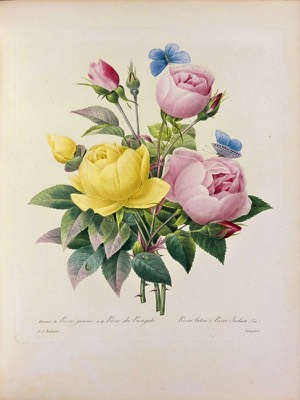
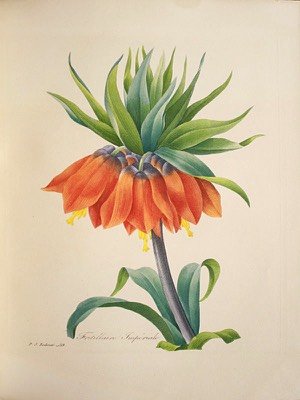
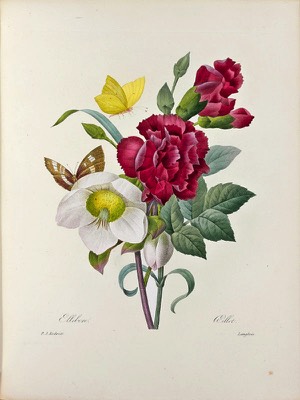
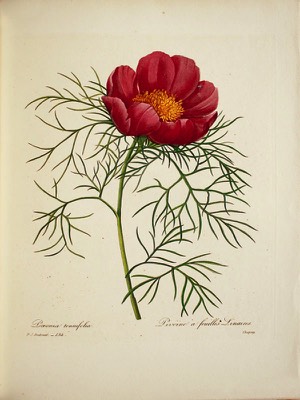
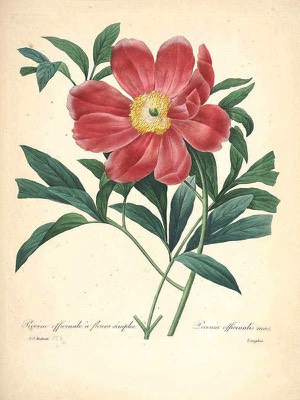
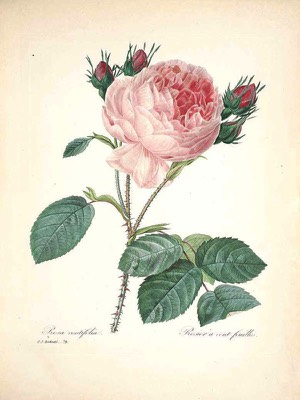
Redouté, Pierre-Joseph (1759-1840).
Choix Des Plus Belles Fleurs et Des Plus Beaux Fruits
Edité par Paris: Ernest Panckoucke, 1833. Folio. (12 6/8 x 9 2/8 inches). Letterpress title-page, Introduction, 16-page "Table Alphabetique et Explicative". 144 stipple-engraved plates, printed in colors and finished by hand, by Langlois, Bessin, Chapuy, and Victor, after Redouté.”Among the most beautiful of all fruit prints. Plates of greengages, plums, peaches, ladyfinger grapes, raspberries, strawberries, apples, pears and apricots are portrayed so perfectly in the delicacy of the stipple modelling that an impression of a third dimension is created" (Dunthorne) The "Choix", for this Redoute's last great and extremely popular work, is personal: "Éclairé par l'expérience, encouragé par les souffrages les plus flatteurs des naturalistes et des peintres de mon pays et des contrées les plus éloignées; c'est en me livrant aux travaux botaniques les plus étendus, c'est en étudiant sans cesse la nature dans la constance et dans la variété des formes et de ses couleurs, que je crois être parvenu à réussir sous le triple rapport d'exactitude, de la composition et du coloris, dont la réunion peut seule porter à perfection l'iconogrpahie végétale" - "Enlightened by experience and encouraged by the extremely flattering pleas of naturalists and painters from my own country as well as from most distant realms; it is by devoting myself to extensive botanical study, by examining nature unremittingly, observing both its constancy and variety of shapes and colours, that I believe finally to have succeeded, by the triple means of exactitude, composition and colouring, the union of which only, may bring to perfection the iconography of plants" (Redouté, "Preface"). Pierre-Joseph Redoute (1759-1840), often called "the Raphael of flowers," was born in the Belgian Ardennes - the son, grandson, great-grandson and brother of artists. From the beginning, Redoute's talents were recognized by distinguished men and women who took pleasure in forwarding his career. For the study of botany, his teacher was Heritier de Brutelle, one of the outstanding naturalists of his day. Gerard van Spaendonck, Flower Painter to the King, taught Redoute the technique of painting in watercolor on vellum. But by the master's own account, the pupil's work was finer. The luminosity of stipple engraving is particularly suited to the reproduction of botanical detail. It is essentially a technique of engraving a copper plate with a dense grid of dots which can be modulated to convey delicate gradations of color. Because the ink lies on the paper in minuscule dots, it does not obscure the "light" of the white paper beneath the color. After this complicated printing process was complete, the prints were then finished by hand in watercolor, so as to conform to the models Redoute provided. Redoute had, as pupils or patrons, five queens and empresses of France, from Marie Antoinette to Josephine's successor, the Empress Marie-Louise. Despite many changes of regime in this turbulent epoch, he worked without interruption, eventually contributing to over fifty books on natural history and archaeology. The "Choix des Plus Belles Fleurs" is one of Redoute's last works. The "choice" is personal, the favorite flowers and fruits of a master who had devoted a lifetime to the arc of botanical illustration. There are the spectacular blooms of formal gardening, but also many more modest blooms of wayside flowers. Although small in size, these prints have the peculiar virtue of concentration, by which we can savour the essence of each beautiful flower. Dunthorne 235; Great Flower Books page 129; Nissen BBI 1591; Stafleu & Cowan TL2 8750; cf. Hunt, Redouteana 21. Price on Request.
Choix Des Plus Belles Fleurs et Des Plus Beaux Fruits
Edité par Paris: Ernest Panckoucke, 1833. Folio. (12 6/8 x 9 2/8 inches). Letterpress title-page, Introduction, 16-page "Table Alphabetique et Explicative". 144 stipple-engraved plates, printed in colors and finished by hand, by Langlois, Bessin, Chapuy, and Victor, after Redouté.”Among the most beautiful of all fruit prints. Plates of greengages, plums, peaches, ladyfinger grapes, raspberries, strawberries, apples, pears and apricots are portrayed so perfectly in the delicacy of the stipple modelling that an impression of a third dimension is created" (Dunthorne) The "Choix", for this Redoute's last great and extremely popular work, is personal: "Éclairé par l'expérience, encouragé par les souffrages les plus flatteurs des naturalistes et des peintres de mon pays et des contrées les plus éloignées; c'est en me livrant aux travaux botaniques les plus étendus, c'est en étudiant sans cesse la nature dans la constance et dans la variété des formes et de ses couleurs, que je crois être parvenu à réussir sous le triple rapport d'exactitude, de la composition et du coloris, dont la réunion peut seule porter à perfection l'iconogrpahie végétale" - "Enlightened by experience and encouraged by the extremely flattering pleas of naturalists and painters from my own country as well as from most distant realms; it is by devoting myself to extensive botanical study, by examining nature unremittingly, observing both its constancy and variety of shapes and colours, that I believe finally to have succeeded, by the triple means of exactitude, composition and colouring, the union of which only, may bring to perfection the iconography of plants" (Redouté, "Preface"). Pierre-Joseph Redoute (1759-1840), often called "the Raphael of flowers," was born in the Belgian Ardennes - the son, grandson, great-grandson and brother of artists. From the beginning, Redoute's talents were recognized by distinguished men and women who took pleasure in forwarding his career. For the study of botany, his teacher was Heritier de Brutelle, one of the outstanding naturalists of his day. Gerard van Spaendonck, Flower Painter to the King, taught Redoute the technique of painting in watercolor on vellum. But by the master's own account, the pupil's work was finer. The luminosity of stipple engraving is particularly suited to the reproduction of botanical detail. It is essentially a technique of engraving a copper plate with a dense grid of dots which can be modulated to convey delicate gradations of color. Because the ink lies on the paper in minuscule dots, it does not obscure the "light" of the white paper beneath the color. After this complicated printing process was complete, the prints were then finished by hand in watercolor, so as to conform to the models Redoute provided. Redoute had, as pupils or patrons, five queens and empresses of France, from Marie Antoinette to Josephine's successor, the Empress Marie-Louise. Despite many changes of regime in this turbulent epoch, he worked without interruption, eventually contributing to over fifty books on natural history and archaeology. The "Choix des Plus Belles Fleurs" is one of Redoute's last works. The "choice" is personal, the favorite flowers and fruits of a master who had devoted a lifetime to the arc of botanical illustration. There are the spectacular blooms of formal gardening, but also many more modest blooms of wayside flowers. Although small in size, these prints have the peculiar virtue of concentration, by which we can savour the essence of each beautiful flower. Dunthorne 235; Great Flower Books page 129; Nissen BBI 1591; Stafleu & Cowan TL2 8750; cf. Hunt, Redouteana 21. Price on Request.

